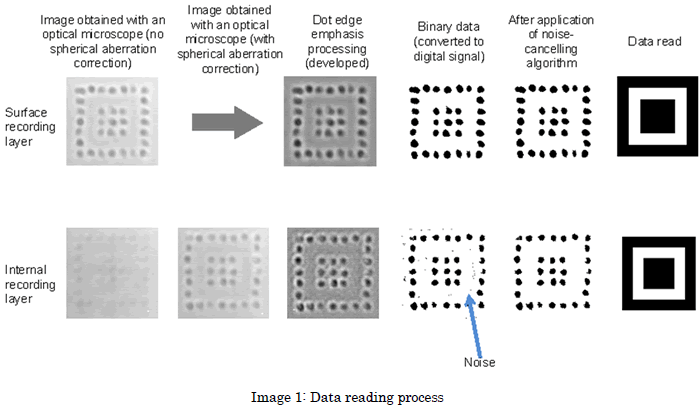Information contained in this news release is current as of the date of the press announcement, but may be subject to change without prior notice.
October 20, 2014
Enabling both greater capacity using 100 recording layers and long storage life
of 300 million years
Tokyo, October 20, 2014 -- Hitachi, Ltd. (TSE: 6501, "Hitachi") today announced that, in collaboration with Professor MIURA Kiyotaka of the School of Engineering, Kyoto University, it has successfully achieved read/write of digital data in 100 layers of fused silica glass, a recording density comparable to Blu-ray Disc™. One hundred multi-layer data recording was verified by the application of newly developed noise reduction technology to overcome interference from data recorded on other layers while trying to access data written in deeper layers within the fused silica glass.
Fused silica glass is known to offer excellent heat and water resistance. It has already been demonstrated that data can be read without degradation even after subjecting the fused silica to an accelerated temperature test of 1,000℃ for 2 hours. This indicates that data archived using fused silica glass can withstand storage of over 300 million years. The use of fused silica is expected to provide new technology for semi-perpetual data storage of valuable data such as historically important legacies and public documents as well personal data that individuals may wish to preserve data for future generations.
With the rapid transition of records from paper to digital media, there is a need to establish long-term storage technology. In particular, with respect to cultural heritages or public documents, semi-perpetual storage technology permitting access to recorded data throughout generations without any degradation resulting from heat or humidity, is necessary. To meet this need, research is being pursued worldwide on various long-term digital data storage technologies including the use of semiconductors and biological DNA.
In 2009, Hitachi focused on fused silica known for its excellent heat and water resistance as a recording medium for long-term digital data storage. After proposing the use of computed tomography*1 to read data recorded with a femtosecond pulse laser*2, fused silica glass was confirmed as an effective storage medium. Applying this technology, it is possible to achieve multi-layer recording by changing the laser's focal point to form microscopic regions (dots) with differing refractive indices. In 2012, a method was developed with Kyoto University to read the recorded dots in 4 layers using an optical microscope (recording density equivalent to a CD), and in 2013, 26 layer recording was achieved (recording density equivalent to a DVD). In order to increase recording density for practical applications, one means is to increase the number of recording layers. At the 100-layer level of recording density equivalent to a Blu-ray Disc™ however issues arose in dot quality degradation and read errors resulting from crosstalk of data recorded in other layers.
To address these issues, Hitachi and Kyoto University identified the factors to realize read/write in 100 recording layers within fused silica glass, and succeeded in demonstrating read/write in 100-layer.
Read/write in 100 layers was verified using the following technologies.
In this work, it was verified that with recording layers with a gap of 60µm between layers, 50 layers can be recorded and read on each side of a fused silica disc, giving a total of 100 layers. The results showed indicated a recording density of 1.5 GB/inch2, comparable to that of a Blu-ray Disc™ is possible using fused silica glass, and the potential for even greater numbers of layers.
Hitachi will continue to conduct tests to verify improved recording density for practical application.
These results are scheduled to be presented at the 2014 "International Symposium on Optical Memory (ISOM2014)" which is being held in Taiwan from 20th October 2014.
Furthermore, making use of the 300 million year data storage lifetime found with fused silica glass, a fused silica glass lithograph is set to accompany an upcoming space launch. The fused silica glass lithograph featuring images and a message for 300 million years in the future will be mounted on the "Shin-en 2" miniature payload of the Hayabusa 2 rocket developed by the Kyushu Institute of Technology (President: MATSUNAGA Morio) and Kagoshima University (President: MAEDA Yoshizane)*3.

Blu-ray Disc™ is a trademark of the Blu-ray Disc Association.
Hitachi, Ltd. (TSE: 6501), headquartered in Tokyo, Japan, delivers innovations that answer society's challenges with our talented team and proven experience in global markets. The company's consolidated revenues for fiscal 2013 (ended March 31, 2014) totaled 9,616 billion yen ($93.4 billion). Hitachi is focusing more than ever on the Social Innovation Business, which includes infrastructure systems, information & telecommunication systems, power systems, construction machinery, high functional materials & components, automotive systems, healthcare and others. For more information on Hitachi, please visit the company's website at http://www.hitachi.com.